Diamond engagement ring alternatives are non-traditional engagement rings that often cost significantly less than typical styles featuring natural diamonds. They use other gems or materials not sourced through traditional mining processes and in much higher supply. Additionally, since many non-traditional stones come in unique shapes and sizes, they offer buyers something truly one-of-a-kind!
Popular diamond engagement ring alternatives include moissanite engagement rings, as well as sapphires, emeralds, rubies and other gemstones. Emeralds have strong historical roots dating back centuries when they were highly sought after by royalty across Europe & Asia. Rubies are another classic gemstone commonly found within engagement pieces, but moissanite is by far the best alternative to diamonds, both in terms of price, quality and colour options.
If you’re still short on cash and can’t afford the engagement ring of your dreams, and are thinking about trying your hand at investing in crypto, get a head start by taking advantage of Canada’s best crypto signup bonuses.
Cryptocurrency Signup Bonuses In Canada
Are you looking for an engagement ring that is unique but at the same time affordable? You’re in luck! We’ve compiled a list of the best diamond engagement ring alternatives that’ll make your significant other’s heart skip a beat. From lab-grown diamonds and other gems to moissanite and even pearls, we’ve got you covered! Our guide will help you choose the perfect ring regardless of your budget. You’ll find some bling within your budget, whether you make $100K a year or just $25K. Whether you’re looking for something classic or modern, we have something for everyone. So why wait? Let’s dive in and explore the world of diamond alternatives together!
What Are Non-Traditional Rings Or Diamond Engagement Ring Alternatives?
Non-traditional engagement rings are those that don’t feature a diamond as the main centre stone. Often referred to as alternative engagement rings, these pieces may be made with coloured gemstones or even feature natural elements such as wood, antler and more. Diamond alternatives for an engagement ring can range from precious stones like sapphires, rubies and emeralds to other materials such as moissanite or lab-grown diamonds. Each option provides couples with a unique way to express their love.
Why Would You Want A Ring With A Diamond Alternative?
The main reasons for choosing an alternative engagement ring over a classic diamond ring include affordability, uniqueness and sustainability. Non-traditional rings often cost significantly less than typical styles featuring natural diamonds because they use other less-rare gems or materials not sourced from traditional mining processes.
Additionally, since many non-traditional styles come in unique shapes and sizes, they offer buyers something truly one-of-a-kind! Finally, opting for an ethically sourced material is beneficial because it avoids environmental damage caused by conventional diamond mining, and it also avoids the many humanitarian issues traditionally associated with modern-day slavery and conflict diamonds!
Choosing Between Popular Diamond Engagement Ring Alternatives
When it comes to alternatives to diamonds, there are dozens of options. You can literally find one for every budget and taste. We did all the heavy lifting and researched the best ones, so you don’t have to. In the following sections, we’ll cover what we found.
Moissanite Engagement Rings
Moissanite engagement rings are perfect for couples looking for something special to commemorate their love. Moissanite is a naturally occurring diamond alternative made from silicon carbide that can be easily grown in a lab. It’s incredibly hard and durable, almost as hard as sapphires, but with more brilliance and fire than even the most exquisite diamond.
Advances in technology have led to a surplus of lab-created moissanite. This lowered its price point to as low as one-tenth the price of a natural diamond of the same carat weight, making it an attractive choice for couples on all budgets.
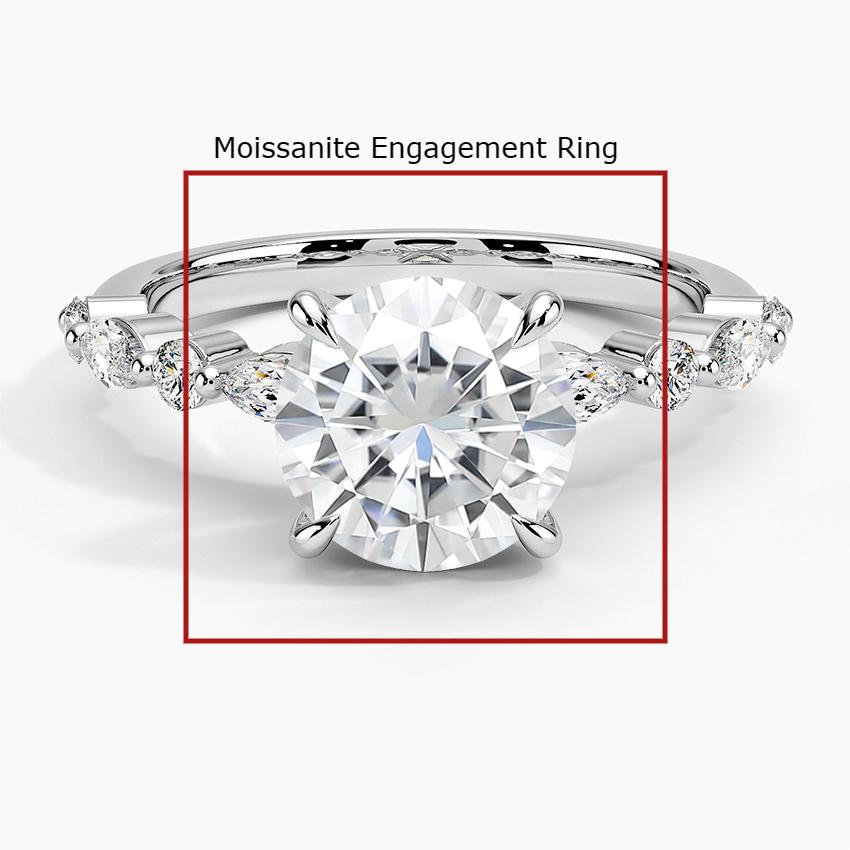
When shopping for moissanite engagement rings, there are several factors to consider:
- Colour – Moissanites come in various colours ranging from near colourless (D-F) to yellowish tones (G-J). When selecting your ring, pick one that matches your bride-to-be’s skin tone or desired look as closely as possible.
- Size – Make sure the size of the moissanite stone you choose will fit within the setting while still being large enough to show off its sparkle.
- Cut – The cut should be chosen carefully since it will determine how much light reflects through the stone creating its signature shine.
- Setting – Consider different metal settings, such as gold or platinum, which can enhance the beauty and durability of your ring design. The good thing about saving so much on the stone is that you can go for a premium platinum ring.
- Quality – Invest in a high-quality moissanite stone and setting to ensure your ring is beautiful and long-lasting.
Natural Gemstones As Alternatives To Diamonds
Sapphires, emeralds, rubies and other gemstones are some of the most popular diamond alternatives for engagement rings. These gems all offer a unique look unlike any other stone. While diamonds may be the traditional choice for an engagement ring, you can choose these precious stones as they add sparkle and colour to any piece of jewelry.
Sapphires
Sapphires come in various colours, from shades of blue to pink, purple and yellow. They have been used as gems since ancient times due to their brilliance and hardness on the Mohs scale (9 out of 10).
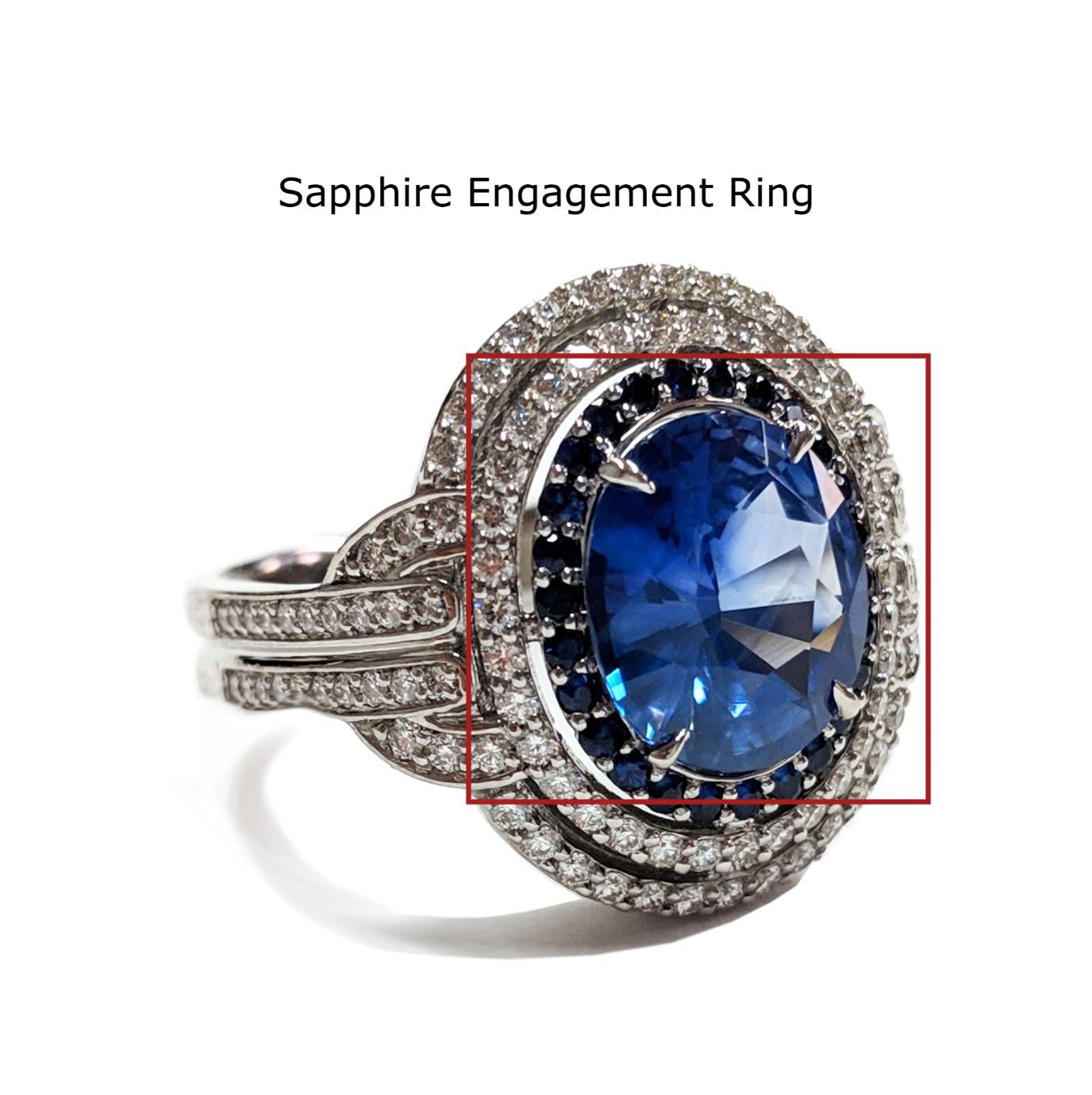
Blue sapphire is the most popular choice, but fancy coloured ones such as golden-yellow or pinkish-orange also exist, making them quite versatile when looking at alternatives to diamonds.
The cost will depend on quality, with larger, more saturated colours being more expensive than lighter hues or smaller sizes.
Emmeralds
Emeralds also have strong historical roots dating back centuries when they were highly sought after by royalty across Europe & Asia. They are rated 7-8/10 on the Mohs scale. So, while they won’t be as hard as sapphires or diamonds, they still possess excellent durability against everyday wear & tear if cared for properly! Similar to sapphires, these come in shades ranging from deep green hues to much lighter greens depending on your aesthetic preference!
They cost anywhere between $500-$7,000 per carat, based on size & colour intensity. Emeralds might stretch some budgets, but they are worth every penny if chosen correctly!
Rubies
Rubies are another classic gemstone commonly found within engagement pieces. However, these tend towards redder tones than the gemstones mentioned above, making them instantly stand out. You can use this quality within specific designs needing colour contrast. For example, you can combine emeralds with gold accents. These gems also have high strength ratings of 8/10, so you can expect longevity.
Good quality rubies are the most expensive of the precious stones. Prices naturally vary widely depending on their colour saturation. However, you can typically expect to spend around $1,000-$5,000 per carat unless you’re lucky enough to stumble across something exceptional at discounted prices.
Other Natural Alternatives
Lastly, other gemstones such as topaz or aquamarine might be another great option when considering alternatives to diamonds. Topaz comes in various colours, from whites and blues to the rare pinks and reds, ranging between 6–8 on the Mohs hardness scale, making them fairly durable.
Aquamarines are also beautiful stones that range from blue hues to greenish tones with a hardness level of 7-7.5/10, making them exceptionally sturdy too! Prices will depend on size & quality but generally expect these gems to cost anywhere between $50-$500 per carat – so much cheaper than the above alternatives!
Coloured Diamonds
Your typical engagement ring is usually set with a colourless or white diamond. But if you’re looking for a more classy alternative, you should consider coloured diamonds. Coloured diamonds come in wide varieties and offer something truly special. These stones could be natural or lab-created and have become increasingly popular as alternatives to traditional white diamonds (lab-grown diamonds are discussed below).
The first thing to consider when choosing coloured diamonds is their hue (the stone’s colour). These colours can fall within several categories:
- Yellowish-browns.
- Greenish-yellows.
- Pinkish-oranges.
- Bluish-greens.
- Purplish-reds.
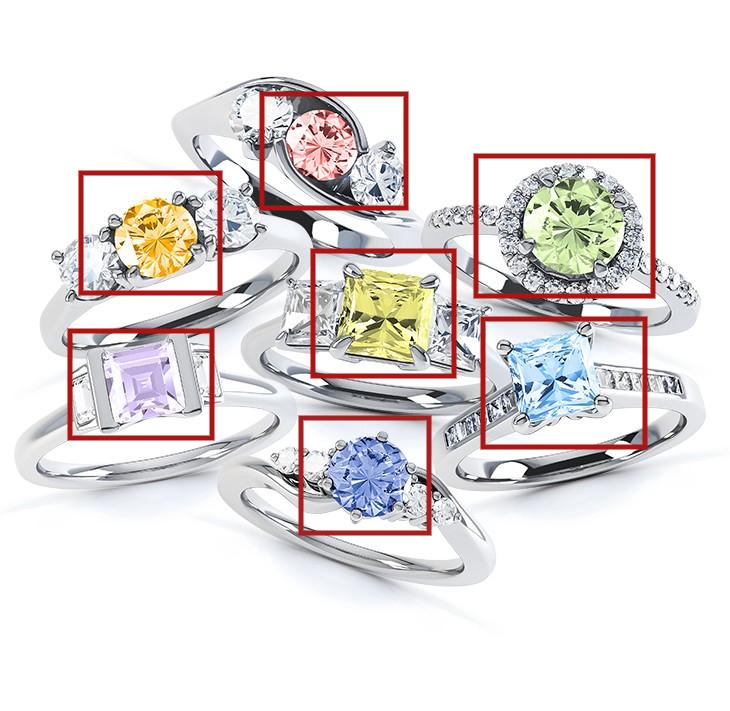
Some people may prefer one over another, but none is better. Pick something that appeals to you or your partner’s personal preference and budget constraints. As before, in addition to hues, saturation also determines the price point, with more vibrant stones costing more than pale ones. You must also consider the stone’s clarity since some imperfections might affect how light reflects off the surface or even obscure its beauty.
Coloured diamonds can range from costly options like fancy deep blue or vivid reds all the way down to cheaper pastel shades like light pinks or faint yellows, depending on what you’re looking for. It’s important, though, before making any decision about buying your gemstone, to shop around among sellers who specialize in coloured diamonds because they usually carry better quality gems at competitive prices.
Also, remember that certain types, such as colour-coated diamonds, laser-drilled and fracture-filled diamonds, require specialized cleaning methods, which will help keep them sparkling longer! Set aside time to research the proper care instructions for whatever coloured diamond you choose.
Pearl Engagement Rings
Pearls are an attractive alternative to diamonds for an engagement ring. They offer unique beauty and elegance, making your special day more memorable. Pearl rings have been popular for centuries, and for good reason—the classic look of these stones is timeless.
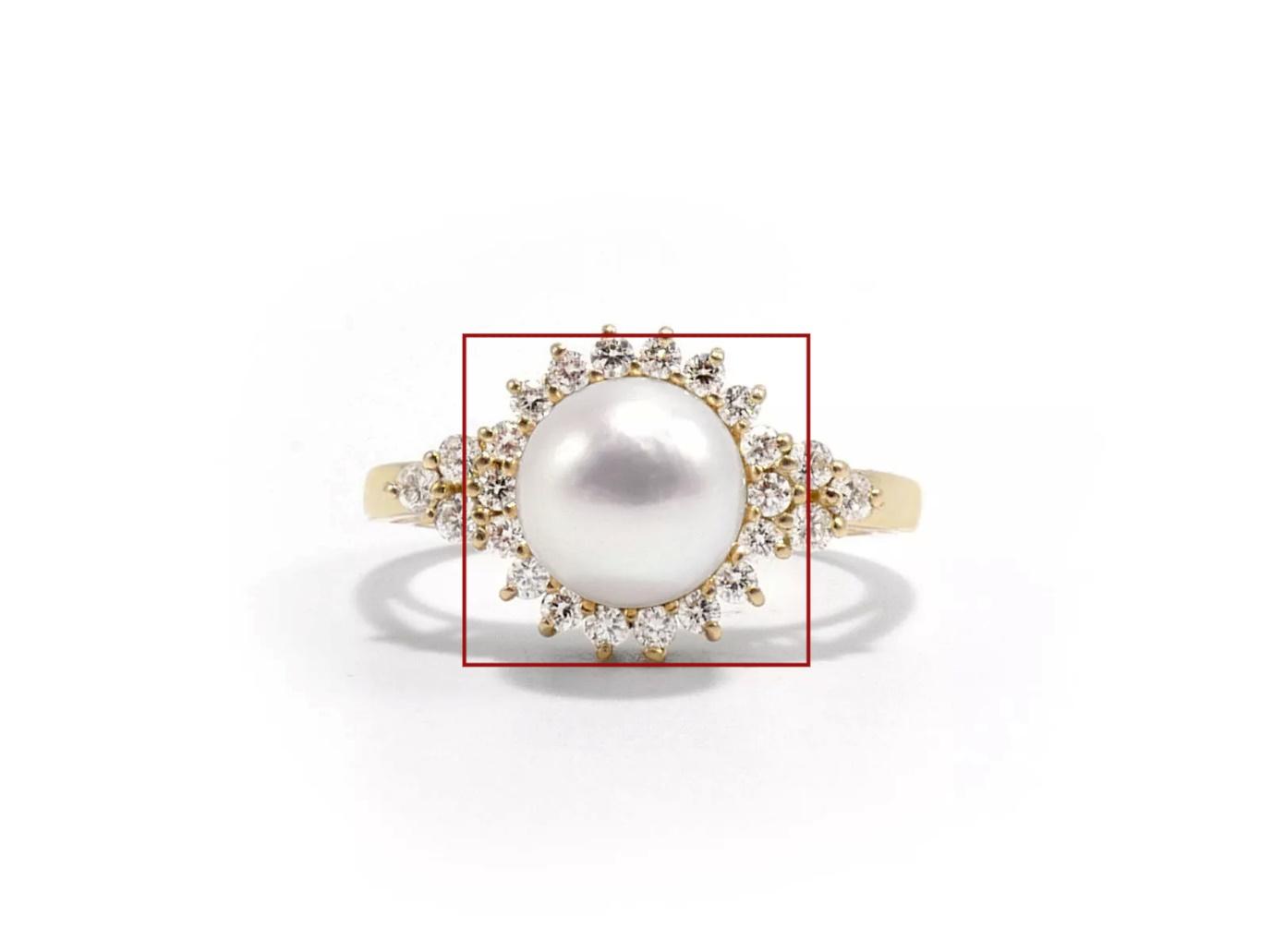
When shopping for a pearl engagement ring, you will want to consider the pearl’s size, shape, colour, and quality grade. Larger pearls are more expensive, but they also provide added interest when worn on a finger—perfect if you want eye-catching glamour! Also, if you want something subtle yet still beautiful, smaller pearls can deliver just that; petite perfection!
The round pearl shape is traditionally used in most engagement ring settings due to its symmetrical design. However, depending on personal preference, you can choose many other shapes, including ovals or pears. There are countless shades available, from white through pinkish tones all the way up to deep hues like black or purple, allowing you to choose one which best suits your personality type.
It’s also important to consider quality. Low grades typically have more blemishes, while higher grades tend to come with few flaws. Good pearls shine bright in any setting, whether in a simple solitaire design or intricate clusters of pearls. Note that regardless of your grade, each pearl should always possess strong lustre. So, take time to inspect it closely before making a purchase decision!
Lab-Grown Gem Stones
Lab-created stones and synthetic gems are popular for engagement rings. Unlike mined diamonds that take millions of years to form in nature, synthetic gemstones can be created from scratch in a matter of weeks with the help of modern science and technology. Lab-created stones offer all the same qualities as natural diamonds but at a fraction of the cost and without any ethical or environmental concerns.
Lab-Grown Diamonds
Lab-created diamonds are made using Chemical Vapor Deposition (CVD). Carbon atoms, the same material that makes up natural diamonds, are heated to extreme temperatures in an oxygen-free environment until they form diamond crystals. The result is a gemstone with all the same physical characteristics as its naturally occurring counterpart (hardness, brilliance and fire), but at a fraction of the price.
Cubic Zirconia
One of the most popular lab-created gems for engagement rings is cubic zirconia (CZ). Cubic Zirconia is an affordable alternative to mined diamonds that can mimic their look and sparkle, and it’s even cheaper than a lab-grown diamond.
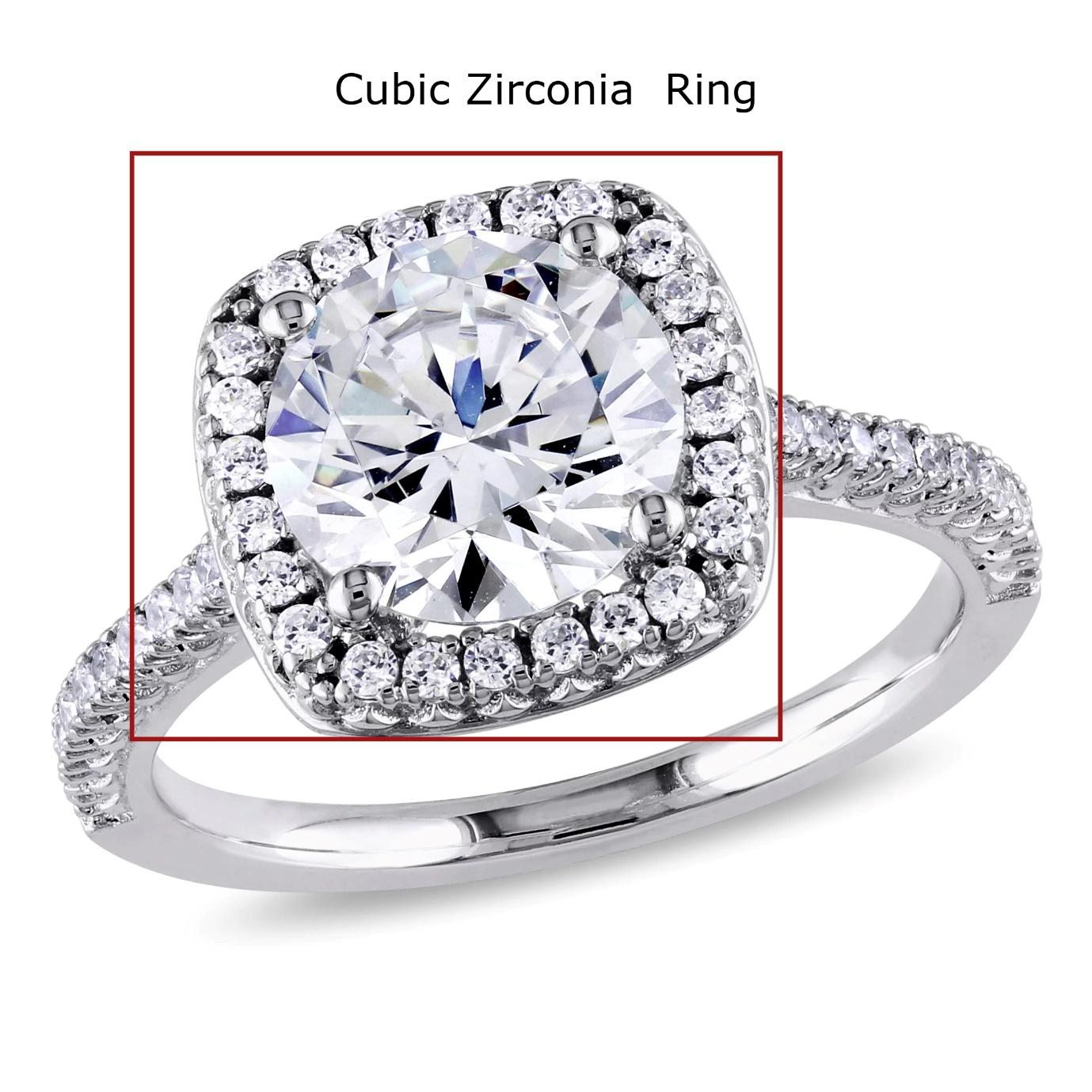
CZs come in many shapes, sizes and colours, so you can find one that fits your style perfectly. Regarding durability, CZs rank 8 on Moh’s scale of mineral hardness—making them durable enough to wear daily without worry.
Synthetic Sapphire
Another great synthetic stone for engagement rings is the synthetic sapphire, created using the flame-fusion method. This process combines aluminum oxide, the same material that forms natural sapphires, and melts it into a single crystal. Synthetic sapphires come in many colours, including yellow, orange and pink—perfect for creating unique engagement rings with pops of colour. They are also highly durable (9 on Moh’s scale), so you can wear them daily without worrying about scratching or chipping them over time.
How To Choose Diamond Engagement Ring Alternatives
There are several criteria you can base your choice on. The most important are:
Cost
When choosing a diamond alternative for an engagement ring, the cost is often the first consideration. Moissanite can be found in almost any price range, making it one of the most affordable. Sapphires and emeralds are also relatively cheap choices; however, rubies tend to be more expensive due to their rarity. Topaz and aquamarine are slightly less costly than sapphires or emeralds. Still, they offer vibrant colours that will stand out in any setting style.
Natural coloured and synthetic diamonds may fall into mid-to high-price ranges depending on quality control factors such as colour intensity, clarity grade, and carat size. These factors affect pricing significantly more than other factors.
Pearls typically have the lowest prices compared with precious stones, but some pearls can be particularly expensive.
On the other hand, cubic zirconia is one of the most economical gems available today. Synthetic sapphire rings generally cost less than natural ones because they lack some characteristics that would otherwise drastically increase their price tag.
The table below shows the relative price ranges for the diamond alternatives discussed above.
| Diamond Alternative | Price Range |
| Moissanite | $100 – $5,000 |
| Sapphires | $100 – $10,000 |
| Emeralds | $500 – $10,000 |
| Rubies | $1000 – $30,000 |
| Topaz | $10 – $500 |
| Aquamarine | $20 – $1,000 |
| Natural Colored Diamonds | $500 – $100,000 |
| Synthetic Diamonds | $100 – $10,000 |
| Pearl | $100 – $10,000 |
| Cubic Zirconia | $10 – $100 |
| Synthetic Sapphire | $100 – $1,000 |
Colour Preferences
The second category when choosing a diamond alternative is colour preferences. Moissanite can be found in various colours ranging from clear to deep yellow, orange hues, blues and even greens. This makes it the most versatile choice if you want something other than traditional white diamonds. Sapphires come in shades of blue, pink, purple, green, yellow, orangish-pink (padparadscha), and more. Emeralds, on the other hand, are usually only available in green. Rubies tend to have a deep red hue that stands out against any metal setting style.
Topaz may appear in various shades, from light yellows to bright oranges. Aquamarine offers subtle hints of blue, often seen within its lighter-toned stones. Natural-coloured diamonds offer intense saturation levels reaching up to fancy vivid grades on the GIA scale.
Synthetic diamonds offer diverse options, including white, black, gray, brown, champagne/cognac, and more, depending on their type. Pearl jewelry has been used for centuries mainly because they come in varying shapes, sizes & colours; though typically, they are off-white or cream tones. Cubic Zirconia is another excellent option since it comes in almost every colour imaginable! Lastly, synthetic sapphire rings can be found in shades of blue, pink, green & yellow.
Setting Style
The third characteristic to consider when choosing a diamond alternative is the setting style. Moissanite is often set as the centrepiece stone in most engagement rings because it can take on any shape or size to create maximum sparkle. Sapphires are well-suited for vintage settings such as three-stone designs, while emeralds tend to look best when they’re part of an elaborate cluster ring design incorporating more than one gemstone into its structure. Rubies complement solitaire styles exceptionally well due to their deep red hue.
However, topaz and aquamarine can also make great centrepieces, depending on your desired overall design concept. Natural Colored Diamonds offer enough intensity & saturation levels to stand out prominently within almost any type of metal setting.
In contrast, synthetic diamonds usually require specific types like pave or flush settings so that all areas have enough sparkle potential from every angle. Pearl jewelry uses mostly classic styling elements such as pronged halos or simple four/six claw mountings for both single pieces & multiple strings alike. With its fragile composition, Cubic Zirconia is best set in a bezel mounting for maximum security, while synthetic sapphire rings can take on any setting style, depending on your preferences.
Quality Control
Quality control is the fourth aspect to consider when choosing a diamond alternative. Moissanite offers excellent value compared to natural stones. This is because it’s made by lab-grown synthesis techniques that produce near-flawless gemstones guaranteed by GIA standards. Sapphires also come graded according to international grading systems such as AGL or GIA.
In contrast, emeralds require special attention during the cutting & polishing processes due to their naturally included nature. Rubies tend not to have any major issues so long as they are sourced from reputable dealers. However, topaz aquamarine and other lesser-known varieties may need further inspection before purchasing to ensure all qualities are up-to-par.
Natural coloured diamonds must go through rigorous testing protocols (such as the 4C’s) to determine authenticity, while synthetic versions should always include certificates proving the origin of production along with detailed information about each stone’s specific characteristics. Pearls are one of the few gems that don’t require any grading system. However, reputable dealers should be used to guarantee quality control & value. Cubic Zirconia is usually treated as a fashioned gemstone so long as it is crafted from high-grade materials. Synthetic sapphire rings must also have certificates verifying their origin and detailed information about each stone’s characteristics.
In Summary
Non-traditional engagement rings don’t have diamonds as the main center stone. People go for these rings for all kinds of reasons, like wanting something more affordable or unique or just wanting to be more sustainable. Some fantastic alternatives to diamond rings include moissanite, sapphires, emeralds, rubies, and other gemstones. These options give you a unique look and can be cheaper than traditional diamonds while giving you a unique way to celebrate your love.
If a short budget is why you’re looking for a diamond engagement ring alternative and are thinking about trying your hand at investing in crypto to get the best piece possible, get a head start by taking advantage of Canada’s best crypto signup bonuses.
Cryptocurrency Signup Bonuses In Canada
- Bitbuy: $50 bonus after depositing $250 or more
- Newton: $25 bonus after depositing $100 or more
- VirgoCX: $20 bonus after depositing $100 or more
Diamond Engagement Ring Alternatives FAQs
What is the best alternative to a diamond?
Moissanite is a gemstone that’s often seen as an alternative to diamonds. It has many of the same qualities as diamonds, including hardness and durability, and even has better shine. It also tends to be more affordable than a diamond of similar quality and size. Moissanite is also unique in its own right; it offers colours such as yellow-green and grayish blue that are not natural for diamonds.
All in all, moissanite is the best alternative to diamonds, particularly for non-conventional engagement rings.
What is the most common diamond imitation?
The most common diamond imitation is cubic zirconia. Cubic Zirconia is an artificial crystal that closely resembles the look and sparkle of a natural diamond. It has been an inexpensive alternative to diamonds in jewelry for decades.
Does moissanite get cloudy?
No, moissanite does not get cloudy.
Is it ok to not have a diamond engagement ring?
Yes, it is absolutely fine not to have a diamond engagement ring. Couples can choose whatever type of ring they prefer for their engagement. Many other types of rings may be more suitable or meaningful depending on the couple’s tastes, preferences, and history.


